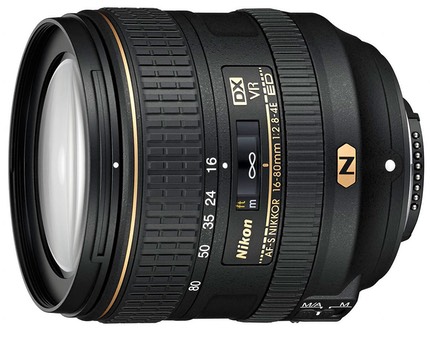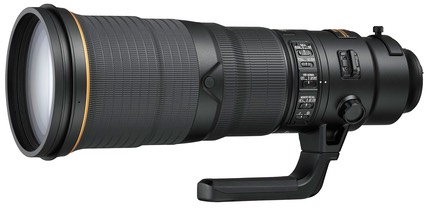(news & commentary)
Okay, truth be told, one new Nikon lens and two updated Nikon lenses.

The new lens is the 16-80mm f/2.8-4E DX VR, essentially the 24-120mm for the crop sensor DSLR crowd that’s been missing in, well, forever. Indeed, Nikon hasn’t had a fast 24-to-anything equivalent zoom for DX in the 16 years of DX until now, which has to make you wonder if anyone at Nikon understands how valuable 24mm is in a mid-range zoom. It took them years to get there in film, too, as they snuck up on the lower end value first with a 35-70mm, then a 28-70mm, and then the now-very-aged 24-70mm.
There’s lots to like about this new Nikon DX lens:
- The f/2.8 at the wide end actually gives us back the stop that DX loses to FX (compared to the 24-120mm f/4 on an FX body).
- But the resulting lens is actually reasonably small as befits DX. Whereas the FX f/4 version is 4.1” long and 670g, the new DX version is 3.3” long and only 480g. If DX is to be sold against FX, it has to have an advantage, and size and weight is one of those, so Nikon is mostly obliging us here.
- This doesn’t appear to be a low-end type of lens. The gold band and Nano coating are one indicator, but the published MTF charts are good for a zoom lens, especially at the telephoto end (though it appears there’s a bit of field curvature). We even get the fluorine coating on the front element to make it averse to water and dust.
- The future is here: this isn’t a G-type lens, but an E-type. What that means is that the mechanical activation of aperture changes is gone, replaced by a fully electronic one. Videographers will be happy, but this also should make rapid shooting more exposure consistent, too.
Many will be put off by the US$1070 pricing, which seems a bit of a stretch even if this lens performs well. A DX user will end up paying more for this lens than they will for their camera.
Lenses are a curious thing at Nikon. This lens had to have gotten its green light to move towards production about two years ago, given Nikon’s design tendencies. It seems pretty clear that this would be the perfect companion to a D300s follow-up, so why did the lens show up and the camera didn’t? Word in Tokyo is that Sony has been having issues with the latest round of APS sensors, both in terms of performance and yield at the fab. It’s quite possible that this lens was mostly intended for a camera that is now otherwise delayed.
Yes, yes, I know, some of you don’t believe that a D300s follow-up is coming, and many of you think it’s too late. I invite you to read the results of my latest survey and see if you still think that. Even if Nikon can’t detect that a D300s follow-up is necessary, I can, you can, and dealers can. Even Canon can ;~). So we’re basically in a “buy the lens and wait for the camera” situation. In the meantime, this will make a very nice mid-range zoom for the D7200 crowd, I think.

Ironically, the other two lenses Nikon announced also play right into the D300s follow-up scenario: the new Nikkor 500mm f/4E FL ED VR (shown above), and the new Nikkor 600mm f/4E FL ED VR. As with the 400mm f/2.8, these lenses get their periodic redesign, this time with the fluorite lens elements and the electronic aperture system. That reduces the weight of the 500mm f/4 by about 20%, as it turns out: now 6.8 pounds (3090g) instead of 8.5 pounds (3880g). The new 600mm now comes in at 8.3 pounds (3810g) instead of 11.5 pounds (5060g). Those are very motivating changes for some of us, as weight restrictions on carry-ons continue to get more and more difficult to navigate.
Of course, you pay for the weight loss: US$10,300 for the 500mm, and US$12,300 for the 600mm. Those prices are going to have more people dipping into the available used pool, I think. While Nikon keeps tweaking the optics, the 500mm f/4, for example, has been exceptional ever since the first manual focus version appeared. Indeed, that lens is still the long-lens bargain to search for if you need a 500mm but live on a pauper’s budget. For awhile you could find excellent copies well under US$2000, though the price has recovered since as people came to their senses and demand exceeded supply at that silly price. Still, my point is this: a few who can justify it buy into the top new version. They sell their previous version to partially pay for it. So what happens when we get these updates is that the hand-me-down used market picks up a bit.
I’ll state it thusly: any of the 500mm f/4 lenses Nikon has made is excellent. What you pay for by buying new is small touches that are quite welcome, but not always necessary for everyone. 20% weight reduction is mighty tempting, though, which is why I expect the 500mm to easily sell out in its initial release. Of course, a 24% price increase will mitigate demand a bit ;~).
Support this site by purchasing from this advertiser:





